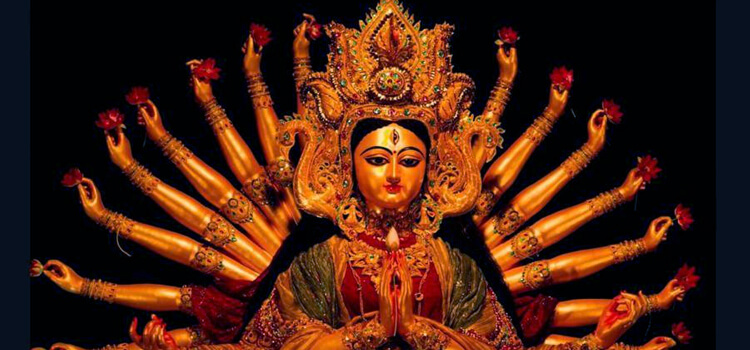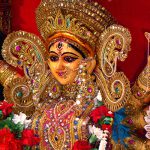What is Maha Navami?
Maha Navami is celebrated a day before Vijayadashami, an important festival of Hindus. It is celebrated for ten days and honors female deities. Dussehra or Navratri is celebrated throughout India. People in different parts of India celebrate it for different reasons. Maha Navami symbolizes the climax of Durga Pooja. Ayudha Pooja is celebrated during the Ashvin month, which falls between September and October.
The festival pays tribute to the attributes of the Divine Shakti (Power) who incarnated as Goddesses Durga and Saraswati to destroy evil and foster the growth of art and culture respectively. Usually, all the Vijayadashami celebrations come to an end with processions of clay deities of Durga, Lakshmi, Saraswathi, Ganesha and Kartikeya, accompanied by music and chants, to the river or ocean. The images are then immersed in the water body after paying homage to the deities with great reverence and respect.
The significance of Maha Navami:
Navratri is a festival of great importance and significance for all and embodies the virtues of feminine Divinity. The festival also celebrates the triumph of good over evil. Mythology speaks of goddess Durga’s battle against the demon, Mahishasur, which went on for nine days. On the ninth or final day, the Goddess slew the demon. On Maha Navami, Goddess Durga is worshipped as Saraswati, the goddess who gives knowledge and wisdom. In Southern India, Ayudha Pooja is celebrated on this day. This pooja is for tools, musical instruments, machineries, books, automobiles and equipment of all kinds including automobiles, are decorated and worshipped. This day is very important as the next day is Vijaya Dashami, which is auspicious for beginning new enterprises.
The Mythology behind Maha Navami
The origins of Maha Navami are steeped in mystery and can be traced back to various mythological tales and legends. It is said that Goddess Durga incarnated with the combined celestial energies of all the Gods to vanquish the evil demon Masishasura, who wreaked havoc on the world with his evil deeds. There ensued a terrible battle for nine days, with the Goddess eventually prevails over the beast and slaying all the evils. She finally restored peace in the world.

Maha Navami also commemorates the victory of Lord Rama over the powerful king of Lanka, Ravana, who abandoned the path of righteousness to satisfy his ego and committed adharma. This forms the story of the epic, Ramayana, which is about the incarnation of Lord Vishnu as Rama to restore order in the world.
Rituals of Maha Navami
This festival is celebrated with great fervor by women. It is more of a community festival, where gifts are exchanged among the ladies. Slokas are chanted early in the morning across all the houses and prayer halls. Mothers pray for the children’s future and good life, especially during Durga Pooja. Ashtami is observed on the eighth day. The ninth day of Navratri is Navami. Dashami is the last day of Durga Pooja, and it is celebrated in a grand manner by offering Goddess Durga fruits, flowers, and special sweet preparations. In Bengal, especially, this is a very important festival and large statues of the Goddess are placed on all streets, accompanied by music and dance. There will be pandals offering delicious food and staging cultural events.
A special Navami homa is performed before the Navami pooja ends. Pooja done on this day is believed to be equivalent to the poojas done on the other nine days of the Navratri festival. The Navami rituals are supposedly performed to bid farewell to Durga who, it is believed, returns to heaven on this day after accomplishing her purpose of slaying Mahishasur.
Benefits of celebrating Maha Navami
Worshipping Goddess Durga on Maha Navami will enable spiritual awakening. Goddess Durga has the power to relieve all the problems of the devotees. Her protection is like a sacred amulet which bestows strength and courage to be successful in all the pursuits.



I don’t think the title of your article matches the content lol. Just kidding, mainly because I had some doubts after reading the article.
Can you be more specific about the content of your article? After reading it, I still have some doubts. Hope you can help me.
I don’t think the title of your article matches the content lol. Just kidding, mainly because I had some doubts after reading the article. https://accounts.binance.com/bn/register?ref=UM6SMJM3